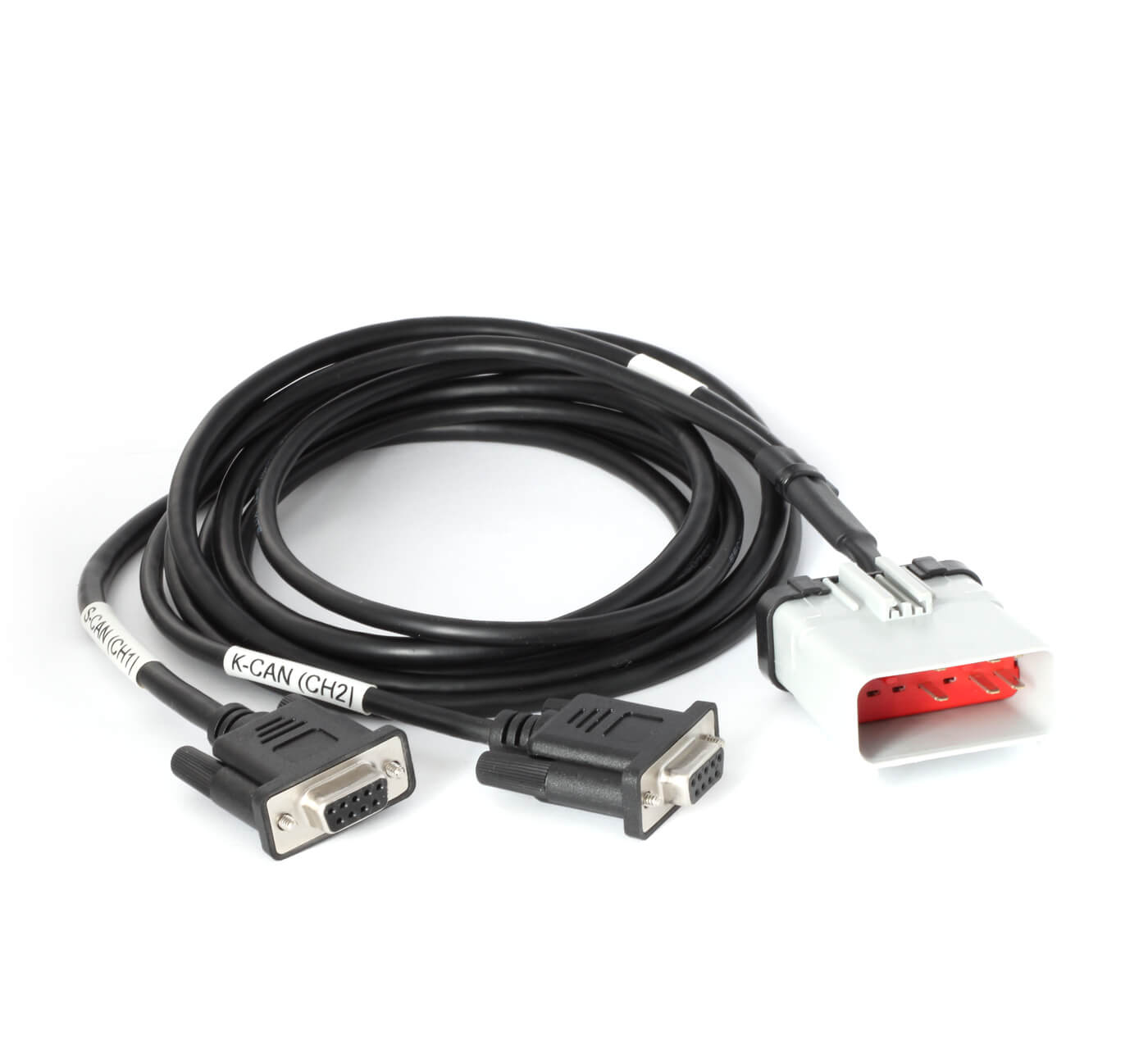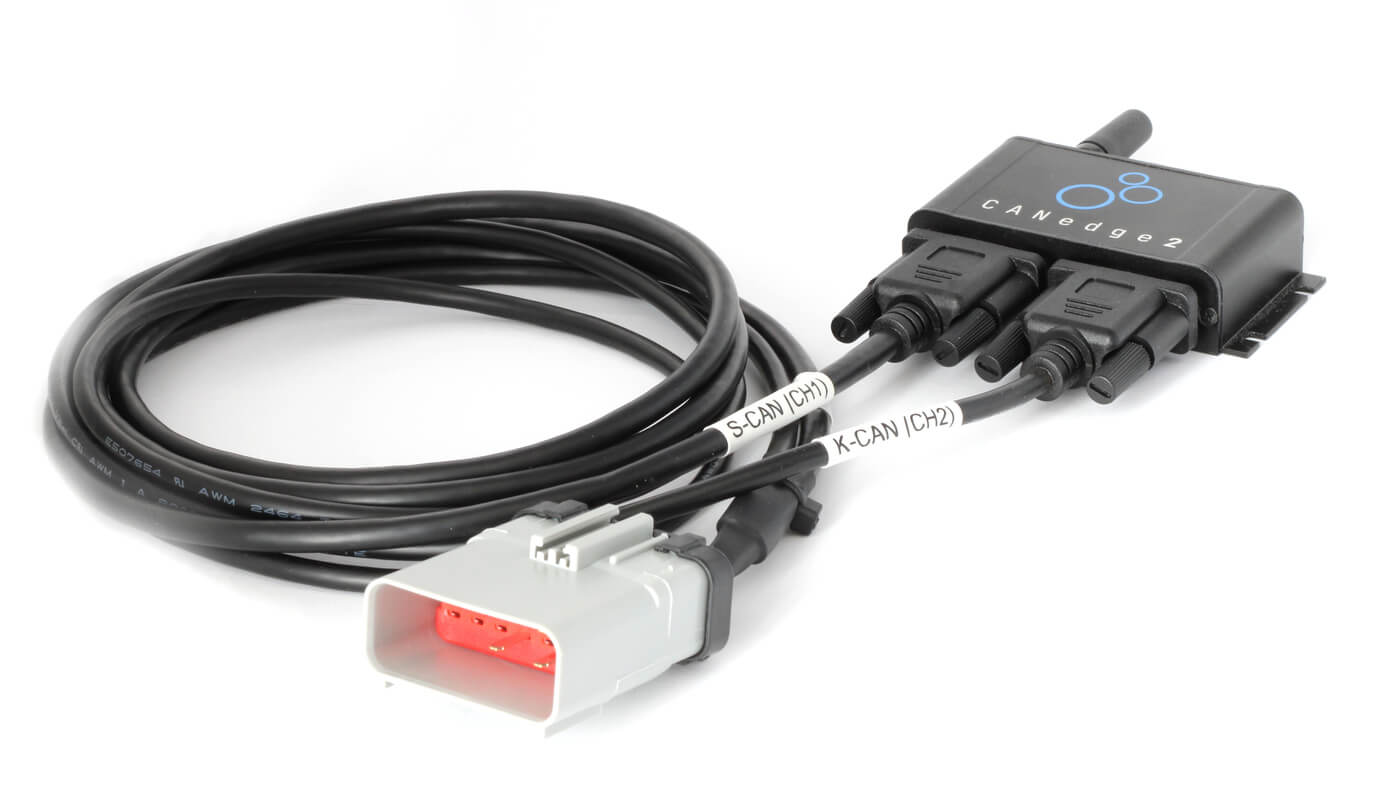
Easily access J1939 data from modern trucks using the RP1226 connector
Log S-CAN and/or K-CAN with a single connector using the CANedge
 HEAVY DUTY
HEAVY DUTY
Compatible with wide range of truck models in North America
 SOLID CABLES
SOLID CABLES
Rugged quality 1.5m cable with overmolded DB9 connectors
 ROHS
ROHS
Cables are RoHS compliant and tested in Denmark
 1Y WARRANTY
1Y WARRANTY
We offer a 1-year warranty on all our products

About the adapter cable
The RP1226 adapter cable is suitable for various truck brands that expose this connector either as a supplement or alternative to the J1939 9-pin Deutsch connector. The RP1226 connector has increasingly been deployed in North American truck brands, incl. Kenworth, Peterbilt, Freightliner, Mack and Volvo, starting with models from 2019-2023+. It is primarily rolled out in North America, driven by the Technology & Maintenance Council (TMC).
The RP1226 connector is often found behind cabin panels or in the center console.
If you need to collect J1939 data from a compatible heavy duty vehicle, you can connect your CANedge easily with this adapter cable. Importantly, the RP1226 connector typically provides access via either S-CAN (pins 2, 9) at 250K or K-CAN (pins 4, 11) at 500K bit-rate. Therefore this adapter cable provides a separate DB9 connector for each of these channels. The RP1226-DB9/DB9 'CH1' connector provides access to the S-CAN pins and power/ground, allowing the CANedge to power up and log data from the S-CAN bus (if it is available). If data is only available on the K-CAN pins aka 'CH2', you simply connect both the CH1 and CH2 DB9 connectors, enabling the device to get power/ground from CH1 and K-CAN data from CH2.
Since the CANedge by default attempts to auto-detect the bit-rate on both CAN1/CAN2, you do not need to configure the device to match a specific truck model - simply connect both DB9 connectors to log data either on CAN1 or CAN2.
Learn more below:

The RP1226-DB9/DB9 connector is ideal if you know that this connector is available in the vehicles you wish to record data from. However, not all trucks support the RP1226 connector. In such cases, the vehicle often instead supports the standardized 9-pin Deutsch J1939 connector, in which case you can use our J1939-DB9 adapter cable. For additional guidance on selecting the right J1939 adapter cable, see our J1939 data logging intro.
Check out our use cases, FAQ - or buy now!
Do you have any questions?
Contact us| GENERAL | |
|---|---|
| Adapter Cable Length | 150 cm |
| Adapter DB9 Pins | In accordance with CiA 303-1 |
| Cable Thickness | 22 AWG (0.50 mm2) |
| Connectors | 2 x 9-pin D-sub (DB9) female to RP1226 male connector |
| Temperature | Operating temperature: -20degC to +80degC |
| Weight | 210G |
| Color | Black |
RP1226-DB9/DB9 adapter pinout
| Function | RP1226 - Male | DB9 - Female 1 | DB9 - Female 2 |
| PROTECTED POWER | 1 | 9 | N/C |
| S-CAN (high) | 2 | 7 | N/C |
| 3 | N/C | N/C | |
| K-CAN (high) | 4 | N/C | 7 |
| 5 | N/C | N/C | |
| 6 | N/C | N/C | |
| IGNITION POWER | 7 | N/C | N/C |
| GROUND | 8 | 3 | N/C |
| S-CAN (low) | 9 | 2 | N/C |
| 10 | N/C | N/C | |
| K-CAN (low) | 11 | N/C | 2 |
| 12 | N/C | N/C | |
| 13 | N/C | N/C | |
| 14 | N/C | N/C |

Below is a use case example where the RP1226-DB9/DB9 adapter is useful:
Vehicle diagnostics and telematics
Need to log J1939 data from a mixed fleet of trucks?
In many telematics use cases it can be relevant to record data from a variety of mixed heavy-duty vehicles. For several North American truck brands, the RP1226 connector may be the simplest way to connect. By using the RP1226-DB9/DB9 adapter, you can easily connect both CAN channels of your CANedge, letting you record J1939 data at either 500K or 250K. The result is a plug & play method for connecting your CANedge across any RP1226 compatible vehicles.
The RP1226 connector is not yet fully standardized, in contrast to e.g. the J1939 9-pin Deutsch connector (see the J1939-13 standard). The RP1226-DB9/DB9 adapter we offer e.g. assumes that power will be available on pin 1 (linked to the ignition). This will most likely be the case in most RP1226 connectors, but there can be exceptions. As such, it is always important to test your setup early on.